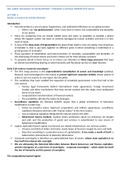Summary
Samenvatting artikelen SDC-32806: Sociology in Development: Towards a Critical Perspective
- Course
- Institution
English summary of 15 articles for the course SDC-32806: Sociology in Development: Towards a Critical Perspective. This course is part of the Master International Development at WUR. Of each article, a long and a short one (often in own words) is available. Minor details are missing these are: ...
[Show more]



